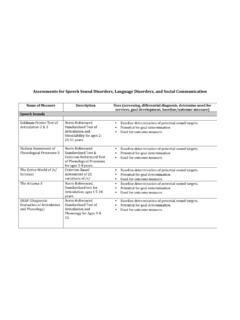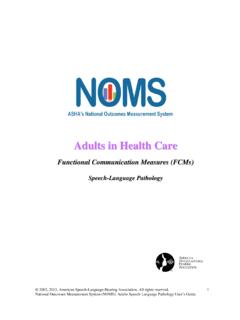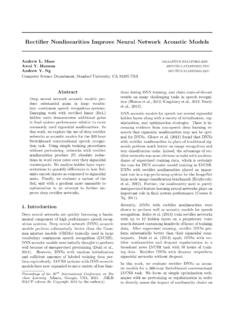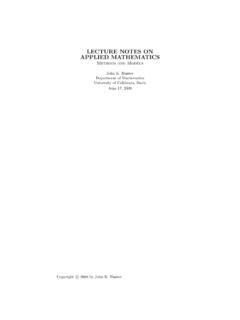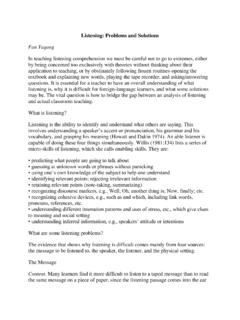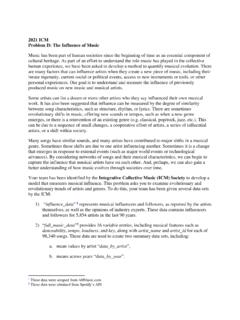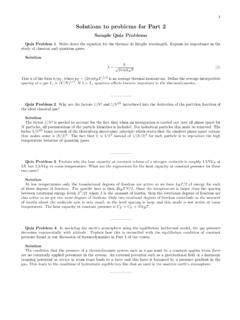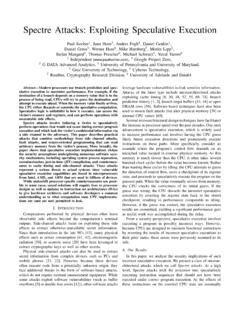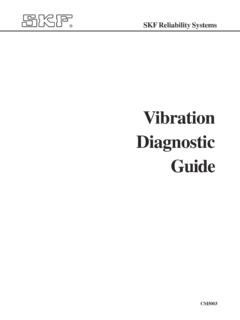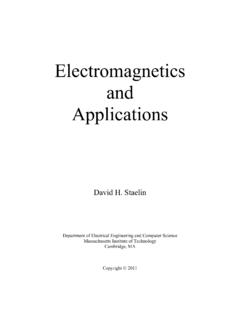Transcription of A Guide to Tympanometry - University of Oregon
1 A Guide toTympanometry forHearing ScreeningTricia K. MikolaiJennifer Duffey, MS, CCC-ADavid Adlin1 IntroductionTympanometry is a testing methodology that is used to evaluate the function of the middle ear. It provides a graphic representation of the relationship of air pressure in the external ear canal to impedance (resistance to movement) of the ear drum and middle ear impedance measurement examines the acoustic resistance of the middle ear. If the eardrum is hit by a sound, part of the sound is absorbed and sent via the middle ear to the inner ear while the other part of the sound is reflected.
2 The information derived from Tympanometry provides the physi-cian with additional information regarding the patient s middle ear function. In a pediatric population this is typically to document or rule out the presence of otitis media, tympanic membrane perfora-tion or Eustachian tube dysfunction. The test is non-invasive and does not require any response from the patient. Typical test time for both ears is less than two a tympanometer worksThe tympanometer has a hand-held probe that is inserted into the ear. Inside the probe are three tubes containing a loudspeaker (figure 1: A), a microphone (figure 1: B) and a pump (figure 1: C).
3 Figure 1 The probe is inserted into the ear canal and forms an airtight seal from the pressure of the eartip against the canal wall. A tone is delivered through the loudspeaker while the pressure is changed within the sealed canal. Then the microphone measures the amount of sound that is reflected back from the eardrum during the pressure sweep. This information is then displayed in graph form the tympanogram. 2 ABC3 The tympanogram A tympanogram provides several pieces of information including: Compliance of the middle ear system (eardrum movement) Ear canal volume Middle ear pressure (normally equal to atmospheric pressure in healthy ears) A pattern that corresponds to various disordersCompliance of the middle ear systemCompliance is plotted vertically on the tympanogram (figure 2).
4 Figure 2 Maximum compliance of the middle ear system occurs when the pressure in the middle ear cavity is equal to the pressure in the external auditory canal. The maximum compliance value occurs at the highest peak of the curve on the graph (figure 3). Figure 3 When you create positive and negative pressure the eardrum stiffens and the compliance decreases. You can then draw conclusions on the condition of the middle ear from the numerical value and shape of the ear pressurePressure is plotted horizontally on the tympanogram (circled in figure 4).
5 Figure 4 Pressure in the external auditory canal is varied from -200 daPa through +400 daPa while monitoring impedance. Impedance is lowest (maximal compliance) when pressure in the canal equals pressure contained within the middle ear space. Therefore you can determine the middle ear pressure by locating the value on the horizontal axis that corresponds to the peak of maximum compliance on the vertical axis (shown with arrows on figure 4). Ear canal volumeAs a general rule, values for ear canal volume should be between and ml (children and adults).
6 A variance will be seen within this range depending on the age and ear structure of the person. For example, a ml or larger reading in a small child could indicate a perforation in the tympanic membrane or a patent tube, while it may be a normal reading in an adult. 4A compliance peak within a normative range (see appendix A on page 13) indicates normal mobility of the middle ear system. A peak found outside of these limits may indicate one of several pathologies. Pattern of the curveFigure 5 shows the Type A curve of a normal tympanogram.
7 This curve is shown as a thick dark line against the shaded area (shading shows the area a normal tympanogram would fall into). Figure 5In a Type A curve, the peak compliance occurs at or near atmospheric pressure indicating normal pressure within the middle ear. This kind of curve has three subcategories: A: Normal shape reflects a normal middle ear mechanism. AD: A deep curve with a tall peak indicates an abnormally compliant middle ear system, as typically seen with ossicular chain dislocation or loss of elastic fibers in the tympanic membrane.
8 AS: A shallow curve indicative of a stiff system, as seen in otosclerosis or thickened tympanic second pattern forms a Type B curve (figure 6). Figure 6A Type B curve has no sharp peak and little or no variation in impedance over a wide sweep range. This is indicative of non-compressible fluid within the middle ear space (otitis media), tympanic membrane perforation, or debris within the external ear canal (cerumen).With the third pattern, a Type C curve (figure 7), peak compliance is significantly below zero (usually less than -200), indicating negative pressure (sub-atmospheric) within the middle ear space.
9 This finding is suggestive of Eustachian tube dysfunction or middle ear 767 acoustic reflex measurementsAn acoustic reflex, or contraction of the Stapedial muscle, occurs under normal conditions when a sufficiently intense sound is presented to the auditory pathway. This contraction of the muscle causes a stiffening of the ossicular chain which changes the compliance of the middle ear system. As in Tympanometry , a probe tone is used to measure this change in compliance. When the stimulus presentation and measurement are made in the same ear by means of the probe, this acoustical reflex is referred to as an ipsilateral acoustic reflex.
10 When the stimulus presentation and measurement are made in opposite ears, the reflex is referred to as a contralateral acoustic acoustic reflex measurement is taken after the tympanogram is performed. For best results, this reflex measurement is automati-cally conducted at the air pressure value where the compliance peak occurred during the tympanometric test. Stimulus tones of varying intensities at 500, 1000, 2000 or 4000 Hz are presented as short bursts. If a change in compliance greater than ml is detected, a reflex is considered present.
